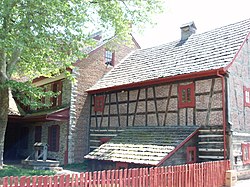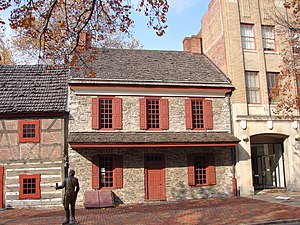
A barn is an agricultural building usually on farms and used for various purposes. In North America, a barn refers to structures that house livestock, including cattle and horses, as well as equipment and fodder, and often grain. As a result, the term barn is often qualified e.g. tobacco barn, dairy barn, cow house, sheep barn, potato barn. In the British Isles, the term barn is restricted mainly to storage structures for unthreshed cereals and fodder, the terms byre or shippon being applied to cow shelters, whereas horses are kept in buildings known as stables. In mainland Europe, however, barns were often part of integrated structures known as byre-dwellings. In addition, barns may be used for equipment storage, as a covered workplace, and for activities such as threshing.

Horatio Lloyd Gates was a British-born American army officer who served as a general in the Continental Army during the early years of the Revolutionary War. He took credit for the American victory in the Battles of Saratoga (1777) – a matter of contemporary and historical controversy – and was blamed for the defeat at the Battle of Camden in 1780. Gates has been described as "one of the Revolution's most controversial military figures" because of his role in the Conway Cabal, which attempted to discredit and replace General George Washington; the battle at Saratoga; and his actions during and after his defeat at Camden.

Timber framing and "post-and-beam" construction are traditional methods of building with heavy timbers, creating structures using squared-off and carefully fitted and joined timbers with joints secured by large wooden pegs. If the structural frame of load-bearing timber is left exposed on the exterior of the building it may be referred to as half-timbered, and in many cases the infill between timbers will be used for decorative effect. The country most known for this kind of architecture is Germany, where timber-framed houses are spread all over the country.

The Barnett Bobb House, also known as the Old Log House, is a historic building in downtown York, Pennsylvania, York County, Pennsylvania. It was originally located at the intersection of Pershing and College Avenues. In 1968, it was moved to its current location and restored. It is on the same site as the General Horatio Gates House and Golden Plough Tavern. It was built in 1811, and is a two-story log dwelling with dovetailed corners. It houses a museum operated by the York County Heritage Trust that showcases family life during the 1830s.

The method of building wooden buildings with a traditional timber frame with horizontal plank or log infill has many names, the most common of which are piece sur piece, corner post construction, post-and-plank, Ständerbohlenbau (German) and skiftesverk (Swedish). This traditional building method is believed to be the predecessor to half-timber construction widely known by its German name fachwerkbau which has wall infill of wattle and daub, brick, or stone. This carpentry was used from parts of Scandinavia to Switzerland to western Russia. Though relatively rare now, two types are found in a number of regions in North America, more common are the walls with planks or timbers which slide in a groove in the posts and less common is a type where horizontal logs are tenoned into individual mortises in the posts. This method is not the same as the plank-frame buildings in North America with vertical plank walls.
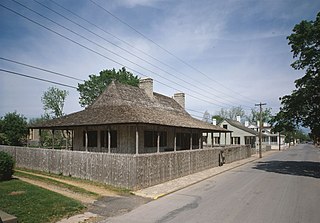
The Louis Bolduc House, also known as Maison Bolduc, is a historic house museum at 123 South Main Street in Ste. Geneviève, Missouri. It is an example of poteaux sur solle ("posts-on-sill") construction, and is located in the first European settlement in the present-day state of Missouri. The first historic structure in Ste. Genevieve to be authentically restored, the house is a prime example of the traditional French Colonial architecture of the early 18th century in North America and was designated in 1970 as a National Historic Landmark.
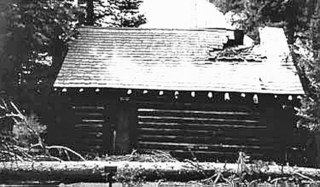
The Death Canyon Barn is a combination barn and ranger patrol cabin in Grand Teton National Park. The barn was built in Death Canyon on the Death Canyon Trail at its junction with the Alaska Basin Trail by the Civilian Conservation Corps in 1935 in the National Park Service rustic style. Located with a clear view of Prospector Mountain, it shares a common style and purpose with the Cascade Canyon Barn to the north in the park, with minor differences attributable to available materials and the preferences of the work crews building the barns.

Log buildings and structures can be categorized as historic and modern. A diverse selection of their forms and styles with examples of architectural elements is discussed in the following articles:

Hill's Tavern is a historic building in Scenery Hill, Pennsylvania. It was heavily damaged by a fire that started shortly before midnight on August 17, 2015. For a period in the early 1900s, the inn was known as Central Hotel. Now called the Century Inn, it has been claimed to have been the oldest tavern in continuous use on the National Road, until the fire brought an end to its 221 years of continuous operation.
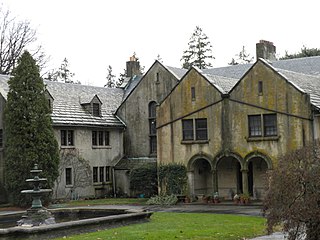
The Allgates is an historic estate which is located in Haverford, Delaware County, Pennsylvania. It was built for financier Horatio Gates Lloyd and his wife Mary Helen Wingate Lloyd.

The Old Rose Tree Tavern is an historic, American inn and tavern that is located in Rose Tree Park, just north of the borough of Media, in Upper Providence Township, Delaware County, Pennsylvania.

The Sturgeon House is a saltbox house dating from around 1838 in Fairview, Erie County, in the U.S. state of Pennsylvania. It was listed on the National Register of Historic Places in 1980. The Sturgeon House is operated as museum by the Fairview Area Historical Society.

Defibaugh Tavern, also known as Willow Grove Tavern, is a historic tavern building located at Snake Spring Township in Bedford County, Pennsylvania. It was built about 1785, and is a 2+1⁄2-story, log-and-frame building with a double stacked porch. The original section was built of logs and it was expanded in the early 19th century. It has a 2+1⁄2-story frame kitchen ell. Also on the property is a small log barn dated to the 18th century.

Cookes House, also known as Tom Paine's House, is a historic home located at York, Pennsylvania, York County, Pennsylvania. It was built in 1761, and is a two-story, Germanic and Provincial Georgian influenced stone dwelling. About 1800, it was converted to a double house. It is the third oldest building in York, after the Gen. Horatio Gates House and Golden Plough Tavern. It is believed to have been the home of Thomas Paine (1737–1809), while the Second Continental Congress convened in York, September 30, 1777, to June 27, 1778.
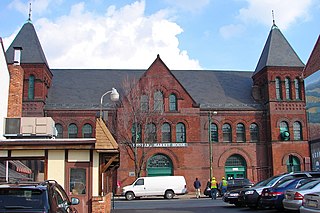
The York Historic District is a national historic district that is located in the central business district and surrounding residential areas of York in York County, Pennsylvania. It is situated north of the Springdale Historic District.

Shelter House is a historic home located in Emmaus, Pennsylvania. Constructed in 1734, it is believed to be the oldest continuously occupied building structure in both Lehigh County and the Lehigh Valley and among the oldest still-standing building structures in the U.S. state of Pennsylvania.

The Hess Homestead, in Lancaster County, Pennsylvania, is a historic Mennonite farmstead near the town of Lititz. The property is an ancestral home of the Hess family, who purchased the land from William Penn's sons in 1735.

American historic carpentry is the historic methods with which wooden buildings were built in what is now the United States since European settlement. A number of methods were used to form the wooden walls and the types of structural carpentry are often defined by the wall, floor, and roof construction such as log, timber framed, balloon framed, or stacked plank. Some types of historic houses are called plank houses but plank house has several meanings which are discussed below. Roofs were almost always framed with wood, sometimes with timber roof trusses. Stone and brick buildings also have some wood framing for floors, interior walls and roofs.

The Langford and Lydia McMichael Sutherland Farmstead is a farm located at 797 Textile Road in Pittsfield Charter Township, Michigan. It was listed on the National Register of Historic Places in 2006. It is now the Sutherland-Wilson Farm Historic Site.
Gates House may refer to:
